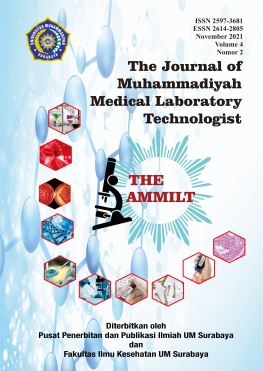Main Article Content
Abstract
Coffee is a psychostimulant drink which can provide good benefits for the body if consumed in moderation. However, one of the effects in excessive coffee consumption over a long period of time that is not accompanied by adequate fluid intake is in fact able to affect sedimentation in urine. The caffeine content which has a lot of particles can cause the kidneys to be unable to reabsorb it. Therefore, it is excreted along with the urine and it causes the urine to be more concentrated. This causes increased sedimentation in the urine. The purpose determined the description of urine sediment examination on coffee connoisseurs in Asrama Kiwal in Brawijaya of Surabaya. The research type used descriptive research with a research sample of 40 people taken by purposive sampling. The results showed that the description of urine sediment examination on coffee connoisseurs at Asrama Kiwal in Brawijaya of Surabaya that 12 people (30%) had normal urine sediment and 28 people (70%) had abnormal urine sediment. Based on the characteristics of the respondents, the presence of abnormal urine sediment was found in the age category 30 years as many as 26 people (76%) with a frequency of coffee consumption > 3 times per day as many as 14 people (35%) in a series of coffee consumption for > 10 years as many as 27 people ( 67.5%) and the frequency of consumption of mineral water 2 litters per day as many as 24 people (60%). The conclusion of this study was that most of the coffee connoisseurs in Asrama Kiwal Brawijaya of Surabaya that experienced abnormal urine sedimentation.
Keywords:Â Coffee, Urine Sediment
Article Details
References
- Azis, R. (2018). Gambaran Hasil Pemeriksaan Sedimen Urin pada Penikmat Kopi di RT 10 RW 03 Kelurahan Lalolara Kecamatan Kambu Kota Kendari. Repository Poltekkes Kendari.
- Bawazeer, N., & AlSobahi, N. (2013). Prevalence and side effects of energy drink consumption among medical at Umm Al-Qura University Saudi Arabia. The Internasional Journal of Medical Students, 8-104.
- Bhara, M. (2009). Pengaruh Pemberian Kopi Dosis Bertingkat Per Oral 30 Hari Terhadap Gambaran Histologi Hepar Tikus Wistar. Skripsi Jurusan Pendidikan Dokter Fakultas Kedokteran Universitas Diponegoro Semarang.
- Dana Priska, N. (2020). Gambaran Kristal Kalsium Oksalat pada Urine Peminum Kopi di Kelurahan Baler Bale Agung Kabupaten Jembrana. Repository Poltekkes Denpasar.
- Ernita. (2011). Hubungan Kebiasaan Minum Kopi Terhadap Kejadian Hipertensi pada Laki - Laki di Kota Lhokseumawe Provinsi Nanggo Aceh Darussalam. Minat Utama Gizi dan Kesehatan Program Ilmu Kesehatan Masyarakat UGM.
- Jan, S., & Monicque M., L. (2011). Effects of Caffeine on Sleep and Cognition. Progress in Brain Research, Vol 190.
- Massey, L. (2004). Acute Caffeine Effects on Urine Composition And Calcium Kidney Stone Risk In Calsium Stone Formers. American Urological Association, 555-558.
- Maughan, R., & Griffin, J. (2003). Caffeine ingestion and fluid balance : a review. Medicine Journal of human nutrition and dietetics : the official journal of the British Dietetic Association.
- Notoadmodjo, S. (2018). Metodologi Penelitian Kesehatan. Jakarta: Rineka Cipta.
- Safitri, E., & Fitranti, D. (2015). Hubungan Asupan Kafein dengan Kalsium Urin pada Laki-Laki Dewasa Awal. Jorunal of Nutrition College, vol. 4, No. 2, hl. 458 .
- Sofiana, N. (2011). 1001 Fakta Tentang Kopi. Yogyakarta: Penerbit Cahaya Atma Pustama hlm 11-30.
- Sola, I. (2020). Gambar Sel Leukosit, Sel Eritrosit dan Bakteri pada Sedimen Urin Sopir BRT Semarang Koridor III. Repository Universitas Muhamadiyah Semarang.
- Strasinger, S., & Lorenzo, M. (2017). Urinalisis dan Cairan Tubuh. EGC.
- Yuliandari, W. (2015). Food Combining Pola Makan Sehat, Enak dan Mudah. Jakarta: PT. Kawan Pustaka.
References
Azis, R. (2018). Gambaran Hasil Pemeriksaan Sedimen Urin pada Penikmat Kopi di RT 10 RW 03 Kelurahan Lalolara Kecamatan Kambu Kota Kendari. Repository Poltekkes Kendari.
Bawazeer, N., & AlSobahi, N. (2013). Prevalence and side effects of energy drink consumption among medical at Umm Al-Qura University Saudi Arabia. The Internasional Journal of Medical Students, 8-104.
Bhara, M. (2009). Pengaruh Pemberian Kopi Dosis Bertingkat Per Oral 30 Hari Terhadap Gambaran Histologi Hepar Tikus Wistar. Skripsi Jurusan Pendidikan Dokter Fakultas Kedokteran Universitas Diponegoro Semarang.
Dana Priska, N. (2020). Gambaran Kristal Kalsium Oksalat pada Urine Peminum Kopi di Kelurahan Baler Bale Agung Kabupaten Jembrana. Repository Poltekkes Denpasar.
Ernita. (2011). Hubungan Kebiasaan Minum Kopi Terhadap Kejadian Hipertensi pada Laki - Laki di Kota Lhokseumawe Provinsi Nanggo Aceh Darussalam. Minat Utama Gizi dan Kesehatan Program Ilmu Kesehatan Masyarakat UGM.
Jan, S., & Monicque M., L. (2011). Effects of Caffeine on Sleep and Cognition. Progress in Brain Research, Vol 190.
Massey, L. (2004). Acute Caffeine Effects on Urine Composition And Calcium Kidney Stone Risk In Calsium Stone Formers. American Urological Association, 555-558.
Maughan, R., & Griffin, J. (2003). Caffeine ingestion and fluid balance : a review. Medicine Journal of human nutrition and dietetics : the official journal of the British Dietetic Association.
Notoadmodjo, S. (2018). Metodologi Penelitian Kesehatan. Jakarta: Rineka Cipta.
Safitri, E., & Fitranti, D. (2015). Hubungan Asupan Kafein dengan Kalsium Urin pada Laki-Laki Dewasa Awal. Jorunal of Nutrition College, vol. 4, No. 2, hl. 458 .
Sofiana, N. (2011). 1001 Fakta Tentang Kopi. Yogyakarta: Penerbit Cahaya Atma Pustama hlm 11-30.
Sola, I. (2020). Gambar Sel Leukosit, Sel Eritrosit dan Bakteri pada Sedimen Urin Sopir BRT Semarang Koridor III. Repository Universitas Muhamadiyah Semarang.
Strasinger, S., & Lorenzo, M. (2017). Urinalisis dan Cairan Tubuh. EGC.
Yuliandari, W. (2015). Food Combining Pola Makan Sehat, Enak dan Mudah. Jakarta: PT. Kawan Pustaka.

